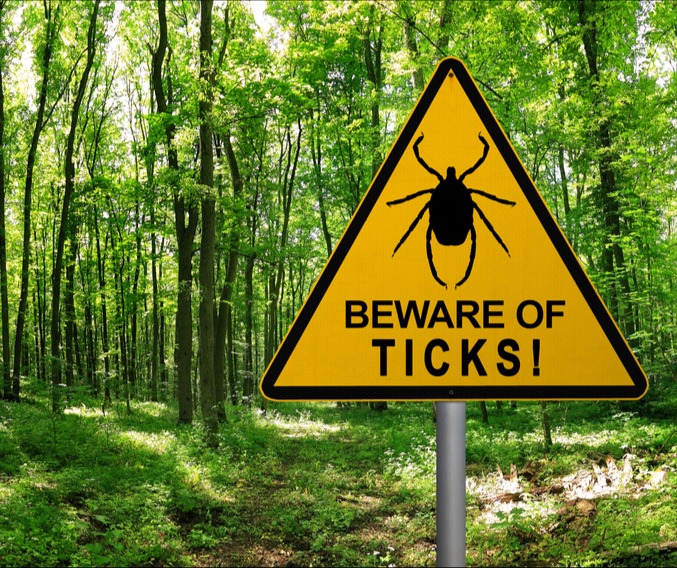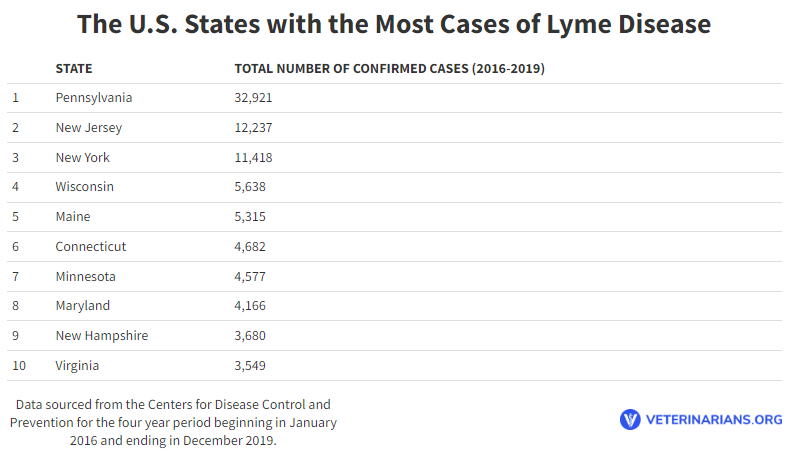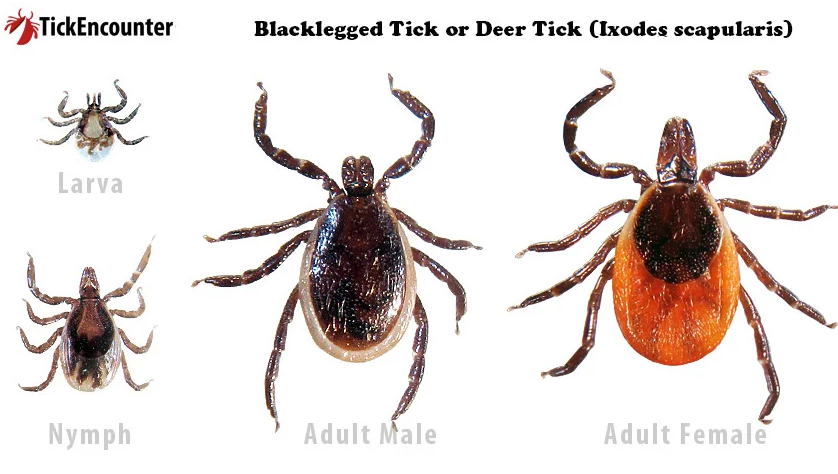The U.S. States with the Most Cases of Lyme Disease

Table of Contents
Blacklegged ticks, which can carry bacteria that causes Lyme Disease, start to become active in the Spring, which is why April is recognized as Prevent Lyme Disease in Dogs Month, and May is recognized as National Lyme Disease Awareness Month for people.
Blacklegged ticks, also known as deer ticks, can attach to both dogs and humans. In fact, the blacklegged tick is one of the most common types of ticks on dogs, and can be easily brought into family homes, posing a risk to companion animals and pet owners alike. An infected tick can transmit the bacteria that causes Lyme Disease to a pet or human with a single bite, provided the tick feeds for at least 24 hours on its host–one of the reasons why prevention and early detection are critical.
The Special Reports Team at Veterinarians.org analyzed four years of data from the Centers for Disease Control and Prevention to determine what states across the nation have traditionally seen the most confirmed cases of Lyme Disease in people.
Following the data, the Team has also included helpful information on protecting your family, including your pets, from tick bites.
The States with the Most Confirmed Cases of Lyme Disease

Pennsylvania tops the list as the state with the most confirmed cases of Lyme Disease during the analyzed time period beginning in January 2016 and ending in December 2019 (2019 is the most recent year made available by the CDC).
Pennsylvania has seen over 32,000 confirmed cases of Lyme Disease over the span of the studied four years. This number makes up nearly a third (32%) of the total number of confirmed cases in the entire nation during this time period (102,727). This number is also 16 times greater than the national average of confirmed cases during the studied time range (2,014).
New Jersey and New York also top the list with over 10,000 confirmed cases each during the analyzed time period. These two states combined make up nearly a quarter (23%) of the total number of confirmed cases in the entire nation during the four years studied.
The top 10 states alone account for 85% of the total number of confirmed cases of Lyme Disease in the United States during the analyzed time period.
As for the regions with the most confirmed cases of Lyme Disease during the four years studied, the Middle Atlantic takes the lead at over 56,000 confirmed cases. This region includes New Jersey, New York, and Pennsylvania, which are the leading states in the ranking. This number accounts for more than half the nationwide total during the studied time period and is more than three times the number of cases seen in the next leading region: New England, which includes Connecticut, Maine, Massachusetts, New Hampshire, Rhode Island, and Vermont, and which saw over 18,000 confirmed cases of Lyme Disease during the analyzed time period.
Why is Lyme Disease so Prevalent in the Middle Atlantic?
The Middle Atlantic region includes the states of New Jersey, New York, and Pennsylvania, as defined by the CDC.
These states have a large population of white-tailed deer, which are the primary hosts of adult blacklegged ticks. This has led to a high density of blacklegged ticks in the region. Unfortunately, blacklegged ticks are the primary carrier of the bacteria that causes Lyme Disease.
The climate and environment of these states also play a role in the prevalence of Lyme Disease. These states have mild winters and warm summers, which provide ideal conditions for ticks to thrive and reproduce. These states are also abundant in wooded and grassy areas, where ticks are commonly found.
Furthermore, the high population density in these states increases the likelihood of human exposure to infected ticks.
Where Can People and Pets Pick Up Blacklegged Ticks?
Blacklegged ticks are most commonly found in wooded or grassy areas, particularly in regions with high humidity. They are most active during the warm months, from spring through fall.
People and pets can pick up blacklegged ticks from a variety of sources, including:
Outdoor activities: Hiking, camping, gardening, and other outdoor activities in wooded or grassy areas can expose you and your pets to ticks.
Wildlife: Blacklegged ticks often feed on deer, mice, and other small mammals. Your pets can pick up ticks by coming into contact with these animals, or by investigating areas where they have been.
Brush and vegetation: Ticks can be found in tall grasses, brush, and other vegetation. Your pets can pick up ticks by walking through these areas, and you can pick up ticks by brushing against plants while hiking or gardening.
Your yard: Ticks can be present in your own yard, particularly if you have wooded or grassy areas. Keeping your yard well-maintained and treating it with pesticides can help reduce the risk of tick bites.
It’s important to be vigilant about checking for ticks after spending time outdoors, and to take steps to protect yourself and your pets from tick bites.
What Does the Blacklegged Tick Look Like?

The blacklegged tick, also known as the deer tick, is a small, hard-bodied tick that is typically brownish-red in color. The adult female tick is about the size of a sesame seed, while the male is slightly smaller.
When the tick has not fed, it appears to have a black head and a black shield behind the head. However, after feeding on a host, its body swells and turns a bluish-gray color, making it easier to spot.
The nymph stage of the blacklegged tick is much smaller than the adult and is typically the stage that most commonly bites humans. It is about the size of a poppy seed and is difficult to see.
Both the adult and nymph stages have eight legs, and they use their sharp mouthparts to attach to their host and feed on their blood.
If you find a tick attached to your skin, it’s important to remove it as soon as possible to reduce the risk of disease transmission. Be sure to use fine-tipped tweezers to grasp the tick as close to the skin as possible and pull upward with steady, even pressure.
How to Keep Your Family/Pets Safe from Tick Bites
Ticks can transmit diseases to humans and pets, so it’s important to take steps to protect your family from tick bites. Here are some ways to keep your family safe from tick bites:
1. Dress appropriately: Wear long-sleeved shirts, long pants, and closed-toe shoes when you are outdoors in wooded or grassy areas. Light-colored clothing makes it easier to spot ticks.
2. Use tick repellent: Apply an EPA-registered tick repellent on exposed skin and clothing before going outside. Follow the instructions on the label and reapply as directed.
3. Check for ticks regularly: After spending time outside, check your body and your children’s bodies for ticks. Pay special attention to areas such as the scalp, behind the ears, under the arms, and in the groin area.
4. Remove ticks properly: If you find a tick, use fine-tipped tweezers to grasp the tick as close to the skin’s surface as possible and pull upward with steady, even pressure. Avoid twisting or jerking the tick, which can cause the mouthparts to break off and remain in the skin.
5. Treat your yard: Keep your yard well-maintained and free of debris, tall grass, and brush piles where ticks can hide. Consider treating your yard with a pesticide that targets ticks.
6. Protect your pets: Use tick preventatives on your pets, check them regularly, and know how to remove tick if you find one. Ticks can hitch a ride on pets and then transfer to humans.
By following these steps, you can help reduce the risk of tick bites and the transmission of tick-borne diseases to your family.














